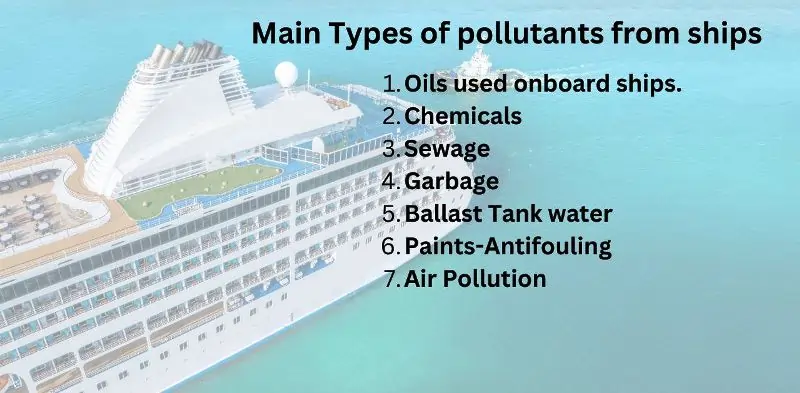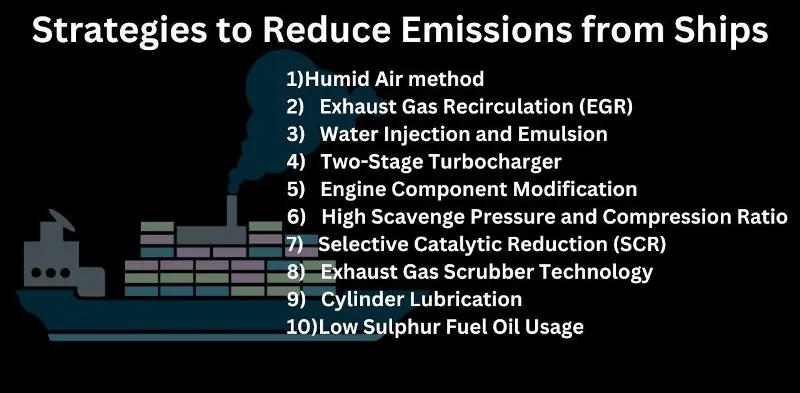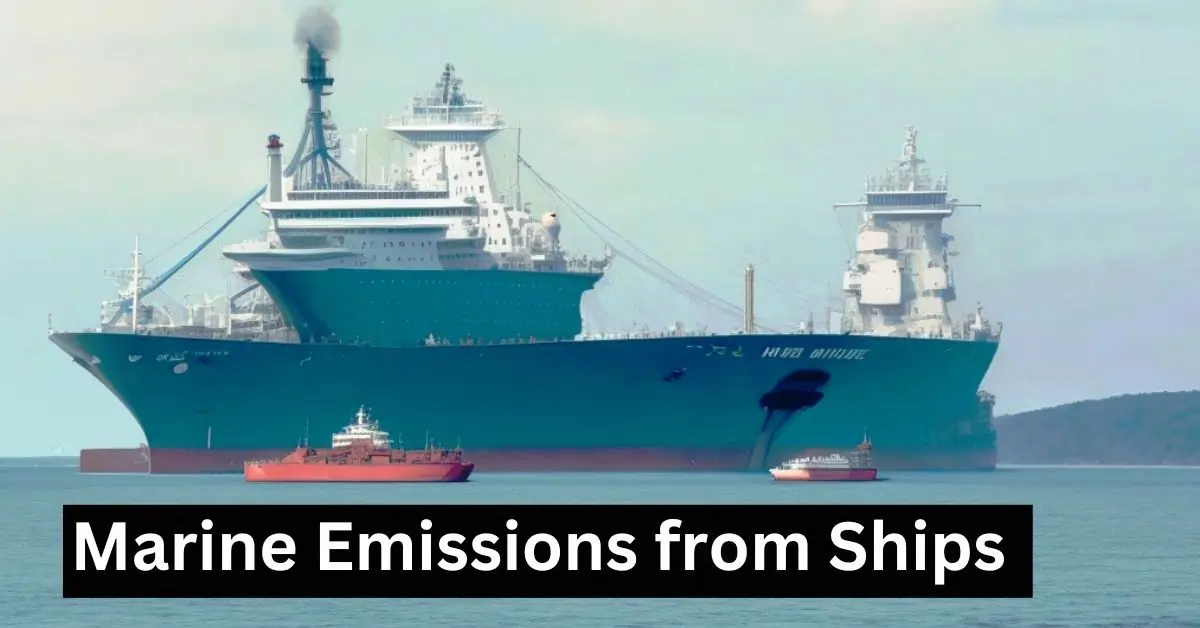Emissions from Ships
The vastness of the oceans hides many secrets, but one secret that’s been surfacing with increasing concern is the problem of marine emissions. As a result of ships spewing significant amounts of pollution, these emissions are more than just a blot on the horizon. They have grown into an ecological challenge of global proportions. As our world’s air and waters see escalating pollution levels, we must decipher and deploy strategies to CONTROL MARINE EMISSIONS.
The repercussions of these maritime emissions stretch far beyond just the marine environment. They cast a shadow over human health, air quality, and the delicate balance of oceanic ecosystems. Recognizing their significance, this post dives deep into:
- Marine Guardianship: Strategies to defend and nurture the marine environment.
- Clearing the Maritime Air: Effective ways to curb air pollution originating from ships.
- Steering with Responsibility: The pivotal role of regulations in limiting vessel air emissions.
- Navigating a Cleaner Path: Initiatives to diminish air pollution in the maritime realm.
Join us in this exploration as we chart a course through the challenges and solutions of marine emissions, equipping ourselves with the knowledge and tools to be part of the solution.
The Imperative of Regulating Air Pollution from Ships
Air pollution from ships isn’t just an incidental byproduct of maritime activities; it’s a significant concern with far-reaching consequences. Unlike natural phenomena, air pollution from ships is entirely human-made, leading to detrimental impacts on air quality. The aftermath of this pollution is not just limited to the marine environment; it exacerbates air quality issues faced by communities across regions and contributes to environmental hazards such as acid rain.
The International Convention for the Prevention of Pollution from Ships (MARPOL) recognizes the gravity of this issue. As a result, stringent measures are in place to ensure global reductions in emissions like SOx, NOx, and particulate matter. Furthermore, the establishment of Emission Control Areas (ECAs) aims to curb further the emissions of these harmful pollutants in designated maritime zones.
A testament to the commitment towards cleaner seas is the recent amendment in MARPOL regulations. As of January 2020, the global sulfur cap has been significantly reduced from 3.5% to a mere 0.5%, reflecting the global drive towards a cleaner and more sustainable maritime environment.
Formula for Calculating CO2 Emissions from Ships
Calculating CO2 emissions. The formula is:

Example Calculation:
If a ship consumes 100 metric tons of fuel, the CO2 emissions can be calculated as:

This formula can be adapted for other pollutants by using the appropriate emission factors for substances like NOx, SOx, and particulate matter (PM). Each pollutant has its own emission factor based on the type of fuel and the specific engine technology.
How to protect Marine Environment
Main Types of pollutants from ships

- Oils used onboard ships.
- Chemicals
- Sewage
- Garbage
- Ballast Tank water
- Paints-Antifouling
- Air Pollution
Environmental Impacts of Various Substances Used Onboard Ships
Ships, while essential for global trade and transportation, can inadvertently contribute to environmental degradation. Here’s a breakdown of the various substances used or generated onboard ships and their potential impacts:
1. Oils:
- Oil spills can have long-lasting, detrimental effects on the environment.
- Such spills pose significant risks to freshwater and marine ecosystems, damaging surface resources and impacting many subsurface species crucial for human food sources.
- Effects of spilled oil:
- Causes physical harm to wildlife, especially birds and mammals.
- It can poison marine creatures.
2. Chemicals:
- Certain chemicals and toxic aquatic substances pose risks to the marine environment.
- Pollutants in this category include:
- Vegetable oils.
- Raw materials from industrial production.
- Effluents from factories.
3. Sewage:
- Discharging sewage into the sea can harm both the environment and humans.
- Risks include contaminating seafood, transmitting diseases to those who use the water, and creating inhospitable conditions for marine life.
- The cumulative effects of sewage discharge from ships can be profound.
4. Garbage:
- Garbage, especially plastics, is a persistent problem in the oceans.
- Small plastic particles can enter the food chain, while larger debris can smother the seafloor and entangle marine mammals.
5. Ballast Water:
- Ships use ballast water for stability. However, marine organisms are often scooped up when taking in this water.
- When discharged in different regions, these organisms can become invasive, threatening local ecosystems and fisheries.
6. Paints (Anti-fouling):
- Anti-fouling paints prevent organism growth on ship hulls.
- But when these paints are scraped off during cleaning, the residue can be toxic to marine environments.
7. Air Pollution:
- Ships emit greenhouse gases like carbon dioxide, sulfur, and nitrous oxide.
- Exhaust gases also contain unburnt fuel and soot particles, which harm the environment and human health.
Understanding these impacts underscores the importance of sustainable maritime practices and regulations to mitigate potential harm.
Essential reasons to pay more attention to MARINE EMISSIONS
Why Marine Emissions Matter
Marine emissions have been in the spotlight because they affect our environment and health. Let’s break down why we should be concerned about them:
More Ships, More Pollution:
- Ships are essential for global trade. As the shipping business grows, more vessels are on the water, leading to more pollution.
- Even with new, cleaner ship technologies, many ships mean more pollution.
Ships vs. Land Industries:
- Factories and power plants on land have started using cleaner methods, reducing pollution.
- However, because they operate internationally, ships have all followed different strict rules. So, while pollution from land might be going down, ship pollution remains a big problem.
Health Risks from Ships:
- Ships release harmful particles and gases. Breathing these in can make people sick.
- Places with many ships have seen more people with breathing problems, showing the direct harm ship pollution can cause.
Harmful Chemical Changes:
- Some gases from ships, like SO2 and NOx, change when they mix with air.
- They turn into tiny particles that can stay in the air for a prolonged, causing smog and dirty air.
Black Carbon Issues:
- Ships release black carbon, a kind of pollution made when fuel doesn’t burn completely.
- This can affect our climate and harm breathing, causing lung and heart problems.
Cancer Concerns:
- Some substances in ship pollution can cause cancer.
- People living near busy ports or coastlines might be at a higher risk because of constant exposure to these pollutants.
Acid rain
Acid rain is linked to SO2 and SO3 in the atmosphere. While SO2 exists mainly as a gas, SO3 often appears as fine particles or particulate matter (PM). When fuels containing sulfur are burned, they produce SOx. This SOx is unwanted as it’s a key air pollutant, similar to NOx. One of the main problems with SOx is that it’s a primary contributor to smog formation.
How to prevent Air pollution from ships?
Strategies to Curb Air Pollution from Ships
As the maritime sector grapples with rising concerns about environmental impact, implementing measures to counteract ship emissions becomes vital. Here’s a comprehensive guide on how to prevent air pollution from ships:
- Fuel Regulations for Marine Emissions:
- Adopting stricter standards for fuel quality can significantly reduce harmful emissions.
- Combustion Enhancement:
- Improving combustion processes can reduce emissions. A significant advantage of this approach is that no external device is required; improvements are made within the engine itself.
- Biofuels:
- Biofuels, derived from plant sources rather than fossil fuels, offer a cleaner alternative. Diesel engines can utilize biodiesel fuels, which are processed by removing glycerol from vegetable oils or animal fats.
- Fuel Governance for Marine Diesel Engines:
- Using high-grade fuels is environmentally friendly, although they might be pricier.
- Liquefied Natural Gas (LNG):
- LNG, when used as fuel, substantially reduces SOx, NOx, and CO2 emissions. For instance, SOx emissions are almost eliminated, and NOx and CO2 can be reduced by about 80% and 25%, respectively. However, the need for specialized storage tanks on ships can be a cost and space challenge.
- NOx Regulations:
- Regulations that limit NOx emissions based on engine output power and speed help ensure that ships meet environmental standards.
- Urea Selective Catalytic Reduction:
- This method, safer than the Ammonia Injection Method, effectively removes NOx from emissions.
- Advancements in Marine Diesel Engines:
- Modern diesel engines are designed for better fuel efficiency and compact size, which aids in lowering carbon dioxide emissions. However, technologies to control harmful particulates and NOx are still essential due to inherent challenges with diesel combustion.
- Environmental Safety and Diesel Engine Technologies:
- The fuel injection system stands out as a pivotal technology for emission reduction. It ensures improved combustion, thereby reducing pollutants.
- The Impulsive Valve timing system, an automated regulation mechanism, helps reduce emissions by adjusting the combustion temperature.
- Advances like the common-rail fuel injection system are crucial in modern emission control techniques.
In essence, tackling marine emissions requires a blend of technological advancements, regulatory frameworks, and a commitment to environmental stewardship.
Strategies to Reduce Marine Emissions from Ships

Reducing environmental impact has become a top priority as the maritime sector evolves. Here are ten comprehensive strategies, each elaborated upon, to help curb marine emissions:
1. Humid Air Method:
- This technique is centered around introducing water vapor into the exhaust gas stream of a ship. By doing so, the overall combustion temperature inside the engine drops.
- As a result, the ship emits fewer hydrocarbons and nitrogen oxides (NOx), two significant pollutants.
- Beyond its eco-friendly advantages, the Humid Air Method enhances engine efficiency and can lead to fuel savings, making it a dual-benefit solution for ship operators.
2. Exhaust Gas Recirculation (EGR):
- EGR is a system that redirects some of the exhaust gases produced during combustion back into the engine’s cylinders.
- This recirculation process significantly decreases NOx emissions, as the returning gases dilute the incoming air, reducing the oxygen concentration and combustion temperature.
- Compliance with international standards, such as those set by the International Maritime Organization, becomes more attainable with EGR.
3. Water Injection and Emulsion:
- Injecting water into the engine or mixing fuel with water creates an emulsion. This diluted mixture burns at a lower temperature, reducing NOx emissions.
- While it’s a promising method, it’s essential to consider the combustion characteristics of specific fuels. Some fuels might not combust efficiently when water-mixed.
4. Two-Stage Turbocharger:
- ABB’s innovative solution involves two stages of turbocharging. The first stage recycles exhausted air, cooling it down before reintroducing it into the combustion chamber.
- The cooled air, when combusted, leads to reduced noise, particulate matter, and NOx emissions. This system enhances power output and overall engine efficiency.
5. Engine Component Modification:
- Modifying or upgrading specific engine components can make combustion processes cleaner.
- Altering systems like air intakes or fuel injection can directly affect combustion efficiency and emission levels. Furthermore, embracing alternative fuels, such as biofuels or LNG, can pave the way for greener operations.
6. High Scavenge Pressure and Compression Ratio:
- Maximizing the air volume in the combustion cylinder makes the combustion process more complete and decreases harmful emissions.
- Ensuring a high scavenge pressure and compression ratio also positively affects fuel efficiency, presenting environmental and economic benefits.
7. Selective Catalytic Reduction (SCR):
- SCR is a post-combustion technology that reduces NOx emissions. It involves injecting a reagent, often urea, into the exhaust, which converts nitrogen oxides into harmless nitrogen and water vapor when passed over a catalyst.
- The efficiency of this method makes it a popular choice, especially as regulations become more stringent.
8. Exhaust Gas Scrubber Technology:
- This technology involves “cleaning” the exhaust gas by passing it through a liquid mixture, usually a blend of chemicals. The resulting reaction significantly reduces pollutants.
- By adopting scrubbers, ships can meet international air pollution standards and contribute positively to global air quality goals.
9. Cylinder Lubrication:
- Ensuring the engine’s well-lubricated cylinders can lead to smoother operations, reduced friction, and lower emissions.
- Advanced lubrication systems, such as the Pulse or Alpha, precisely regulate oil delivery, optimizing efficiency and reducing wear and tear.
10. Low Sulphur Fuel Oil Usage:
- Sulfur oxide emissions are a significant concern in the maritime sector. Using low sulphur fuel directly reduces these emissions.
- Despite being pricier, low-sulfur fuels ensure compliance with emission standards, especially in regions with strict controls like Emission Control Areas (ECAs).
While effective, each strategy underscores the maritime sector’s commitment to balancing efficient operations and environmental stewardship.
Strategies for Ships to Lower Carbon Emissions
Shipping, a cornerstone of global commerce, has long relied on fuel reserves to propel massive vessels across vast distances. However, the environmental footprint of this immense energy consumption, primarily in terms of carbon emissions, is becoming increasingly untenable.
The immediate and most apparent approach to diminish the carbon footprint of ships is a transition to cleaner fuels that emit fewer greenhouse gases and pollutants.
Moreover, engine design and efficiency advancements can further contribute to this cause. Modern engines can extract more power from the same amount of fuel, translating to less fuel consumption and, by extension, reduced emissions.
In addition, auxiliary measures such as optimizing routes using real-time data analytics, employing energy-saving technologies on board, and enhancing hull designs can further conserve energy.
In conclusion, as the urgency to address climate change intensifies, the shipping industry has a pivotal role. With cleaner fuels, improved engine efficiency, and innovative vessel designs, ships can substantially decrease carbon emissions, steering global commerce toward a more sustainable future.
Embracing Green Technologies in the Shipping Sector
Shipping contributes a lot to global pollution. To combat this, the industry is exploring eco-friendly solutions. One innovative approach is to equip ships with solar panels. By using the sun’s energy, ships can reduce fuel usage by saving around 20% on fuel expenses and lowering emissions. Given the tightening regulations on maritime emissions, solar panels are a step in the right direction.
Another advancement is in the design of ship propellers. Improved methods can decrease fuel consumption by up to 4%. While this might seem minor, adopting it widely could drastically reduce global marine emissions.
The Speed Injector is also introduced, designed to boost ship speed without consuming extra fuel, offering savings of up to 5%.
In essence, the shipping industry is gearing up for a greener future. By embracing these sustainable technologies and practices, it’s playing a pivotal role in preserving our environment.
FAQ on Marine emissions
Q: What are marine emissions?
A: Marine emissions refer to pollutants released into the atmosphere from ships’ engines and operational processes.
Q: Why are marine emissions a concern?
A: They contribute to air pollution and climate change and can adversely affect human health and marine ecosystems.
Q: How can ships reduce their emissions?
A: Ships can adopt cleaner fuels, improve engine efficiency, and implement technologies like scrubbers and selective catalytic reduction.
Q: Are there international regulations on marine emissions?
A: Yes, the International Maritime Organization (IMO) sets global standards to limit harmful emissions from ships.
Conclusion: Addressing the Challenge of Marine Emissions
As we navigate the vast expanse of the maritime industry, it’s evident that controlling marine emissions is not just an environmental imperative but a collective responsibility. The seas connect continents, power economies, and enable global trade. However, with the myriad advantages come challenges, with marine emissions topping the list.
The consequences of unchecked marine emissions are manifold, from deteriorating air quality to the broader implications of climate change. Yet, the industry can set a new course with innovative technologies, stringent international regulations, and a collective commitment to sustainable practices. By adopting cleaner fuels, enhancing engine efficiencies, and leveraging advanced emission control technologies, ships can sail more cleanly, ensuring both blue skies above and blue seas below.
The journey to curbing marine emissions is undeniably complex but worth embarking upon. After all, safeguarding our planet’s health ensures smooth sailing for future generations.
